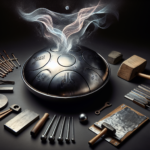<!DOCTYPE html>
<html lang="en">
<head>
<meta charset="UTF-8">
<meta name="viewport" content="width=device-width, initial-scale=1.0">
<title>Handpan Guru: An Odyssey in Ethereal Soundscapes</title>
<style>
body {
font-family: Arial, sans-serif;
line-height: 1.6;
color: #333;
padding: 20px;
}
h1, h2, h3 {
color: #01579b;
}
p {
margin-bottom: 15px;
}
.faq {
margin-top: 30px;
}
.faq h3 {
margin-bottom: 10px;
}
</style>
</head>
<body>
<h1>Handpan Guru: An Odyssey in Ethereal Soundscapes</h1>
<p>
The handpan, a once-uncommon musical instrument, is now resonating with communities across the globe, celebrated for its ethereal and melodic tone. This curious instrument's appeal lies not just in its unique sound but in its power to create immersive auditory experiences. The journey of understanding and mastering the handpan can be likened to an odyssey—an exploration into an almost spiritual soundscape where rhythm and harmony collide in a dance of peaceful expression.
</p>
<p>
At the heart of this journey is the handpan guru, a master not only of the technical proficiency required to create music but also of the deeper art of interpreting the emotional and metaphysical potential of the instrument. The role of the guru is not simply that of a performer but a guide for those new to the handpan world—a world rich with possibility and wonder.
</p>
<h2>The Origin and Evolution of the Handpan</h2>
<p>
The handpan was born at the turn of the 21st century, evolving from the Caribbean steel drum. This modern instrument surfaced in Switzerland in 2001, crafted by Felix Rohner and Sabina Schärer of PANArt. Initially dubbed the "Hang," it was a reinterpretation of the traditional steelpan, offering greater versatility through its convex shape.
</p>
<p>
Over time, the instrument gained notoriety for its serene, hypnotic sound, which seemed to transcend the boundaries of traditional musical structures. As its popularity grew, so did the diversity of handpan models and makers, each adding their own flair to the instrument's design and tonal characteristics. Today, the handpan exists in a variety of scales and materials, broadening the scope for musical exploration.
</p>
<h2>Crafting Soundscapes: The Handpan Guru's Role</h2>
<p>
A handpan guru does more than merely play notes—they sculpt soundscapes. These experts understand that each handpan has a unique voice shaped by its scale, tuning, and the material used in its construction. Mastering a handpan is akin to learning a new language; it requires a keen ear and an intuitive touch to coax the natural resonance of the instrument.
</p>
<p>
One of the most profound abilities of a handpan guru is their capacity to connect with audiences on an emotional level. By blending rhythm, resonance, and silence, they compose pieces that engage listeners, often evoking a meditative state. The handpan's spherical form encourages continuous playing, fostering flowing compositions that invite listeners into their unfolding narrative.
</p>
<p>
Teaching this craft involves guiding students through the intricacies of tapping, stroking, and muting the handpan's surface to produce a broad palette of sounds. A true guru leads students on a path to discover their unique voice within the intriguing void that the handpan soundscape can sometimes present.
</p>
<h2>Handpan Communities and Cultural Impact</h2>
<p>
Over the years, handpan music has blossomed into a significant cultural phenomenon, finding its place in diverse settings such as yoga classes, therapeutic practices, and communal gatherings. Part of this cultural revolution includes the proliferation of handpan communities, both online and offline, where enthusiasts share experiences, techniques, and compositions.
</p>
<p>
These communities are pivotal in fostering an inclusive environment where skill level is secondary to the shared love for the instrument and its calming influence. Events like handpan festivals have sprung up worldwide, gathering musicians, makers, and listeners alike to celebrate the gentle, transcendent sound of the handpan.
</p>
<h2>The Spiritual Dimension of Handpan Playing</h2>
<p>
For many, playing the handpan transcends music; it becomes a spiritual practice. The instrument's sound is often described as mesmerizing, reminiscent of nature's elements like flowing water or rustling leaves. The harmonic overtones produced when playing a handpan can elevate the experience into one of meditative introspection and mindfulness.
</p>
<p>
Handpan gurus teach that at its core, making music with this instrument requires presence and intent. The relationship of musician to instrument is symbiotic; understanding this is crucial for creating music that resonates beyond the auditory and into the spiritual realm. Many claim that playing the handpan brings a unique sense of peace and fulfillment not easily found in more conventional forms of musical endeavor.
</p>
<h2>Mastering the Handpan: A Lifelong Journey</h2>
<p>
Mastery over the handpan is not just about technical skill, nor can it be measured by routines or exercises mastered. It is, instead, an ongoing journey where each session with the instrument offers new challenges and revelations. Investing time to understand the musical scales, experimenting with improvisation, and learning from other experienced players are all part and parcel of this journey.
</p>
<p>
The handpan invites its players to constantly re-evaluate their approach and embrace experimentation. Within the minimalist design, there exists an abyss of complexity and nuance; each playing session is an opportunity for discovery.
</p>
<h2>Conclusion</h2>
<p>
The handpan remains a relatively new instrument on the global stage, yet its influence is growing steadfastly. Its hauntingly beautiful soundscapes continue to capture the hearts of musicians and listeners alike. Handpan gurus offer insights not only into technical playing but into the spiritual and emotional depths the instrument can reach. As more individuals take up this cymbal-like sound vessel, the handpan community will undoubtedly continue to grow, making this beautiful, celestial sound more accessible to ears yearning for its ethereal touch.
</p>
<div class="faq">
<h2>Frequently Asked Questions</h2>
<h3>1. What makes a great handpan guru?</h3>
<p>
A great handpan guru combines technical proficiency with emotional sensitivity. They need to guide students through the nuances of sound crafting, helping them discover their own musical voice while fostering a deep connection to the art of handpan playing.
</p>
<h3>2. How is the handpan different from traditional steel pans?</h3>
<p>
While both instruments share a similar origin in the steel drum family, the handpan offers a more mellow and ethereal sound due to its convex shape and specific tuning methods. This results in a wide range of harmonic possibilities not typically found in traditional steel pans.
</p>
<h3>3. Is the handpan difficult to learn?</h3>
<p>
Learning the handpan can vary in difficulty based on one's musical background. However, its intuitive design allows beginners to produce pleasing sounds relatively quickly, while advanced techniques offer a lifetime of learning opportunities for seasoned musicians.
</p>
<h3>4. Where can I find a community of handpan players?</h3>
<p>
Handpan communities are active both online and offline. There are numerous forums, discussion groups, and social media platforms dedicated to handpan enthusiasts. Additionally, handpan festivals and workshops are excellent opportunities to meet fellow players and exchange knowledge.
</p>
<h3>5. Can I use a handpan for meditation?</h3>
<p>
Yes, many people find the soothing sounds of the handpan conducive to meditation and mindfulness practices. Its ability to produce calming and rhythmic tones makes it an ideal choice for creating a peaceful meditative atmosphere.
</p>
</div>
</body>
</html>Handpan Guru: An Odyssey in Ethereal Soundscapes

Leave a comment




